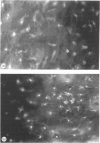Abstract
Liposomes containing the drug dichloromethylene diphosphonate (Cl2MDP) can eliminate phagocytic cells, such as macrophages, when injected in vivo. In this paper we report that Cl2MDP-containing liposomes have been used experimentally to determine the extent to which cutaneous macrophages participate (1) in the induction of contact hypersensitivity (CH) when hapten is painted on normal murine skin, and (2) in the induction of CH or tolerance when hapten is painted on murine skin that has been exposed to ultraviolet B (UVB) radiation. Intradermal (i.d.) injections of Cl2MDP-containing liposomes were found to have no deleterious effects on CH induction via normal skin, whether the amount of hapten (dinitrofluorobenzene) applied to the cutaneous surface was optimal or excessive. Moreover, Cl2MDP-containing liposomes did not deplete the epidermis of Langerhans' cells. However, similar i.d. injections of Cl2MDP-containing liposomes did prevent the induction of CH when hapten was painted on UVB-irradiated skin of BALB/c mice, a strain that develops CH when hapten is applied to UVB-exposed skin. These findings indicate that the antigen-presenting cell (APC) function found in skin of UVB-resistant mice following exposure to UVB radiation can be attributed to macrophages. This explains why these mice develop and display CH after UVB radiation. By contrast, i.d. injections of Cl2MDP-containing liposomes failed to prevent the induction of the tolerance when hapten was applied to the surface of UVB-exposed skin of UVB-susceptible mice, such as C57BL/6. Since the dermis of UVB-exposed skin of these mice is known to contain a novel population of cells that can provide a tolerance-conferring signal, the current findings rule out macrophages as the responsible cell type.
Full text
PDF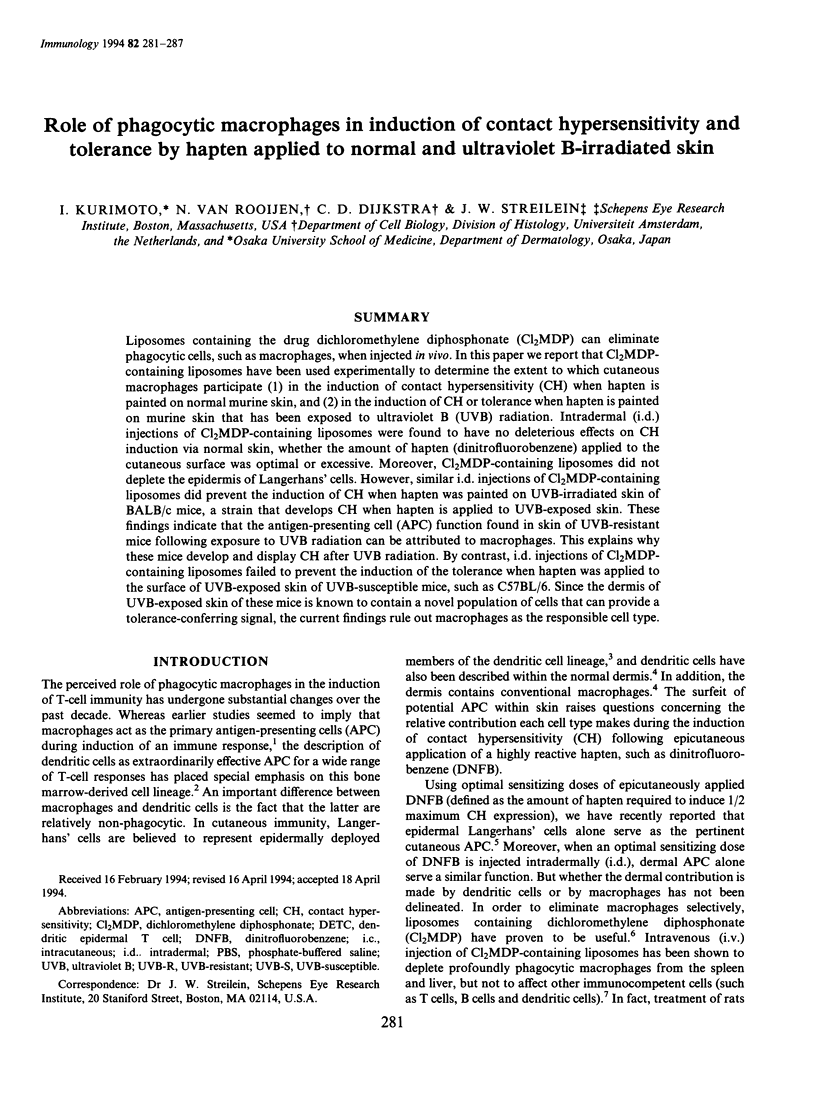
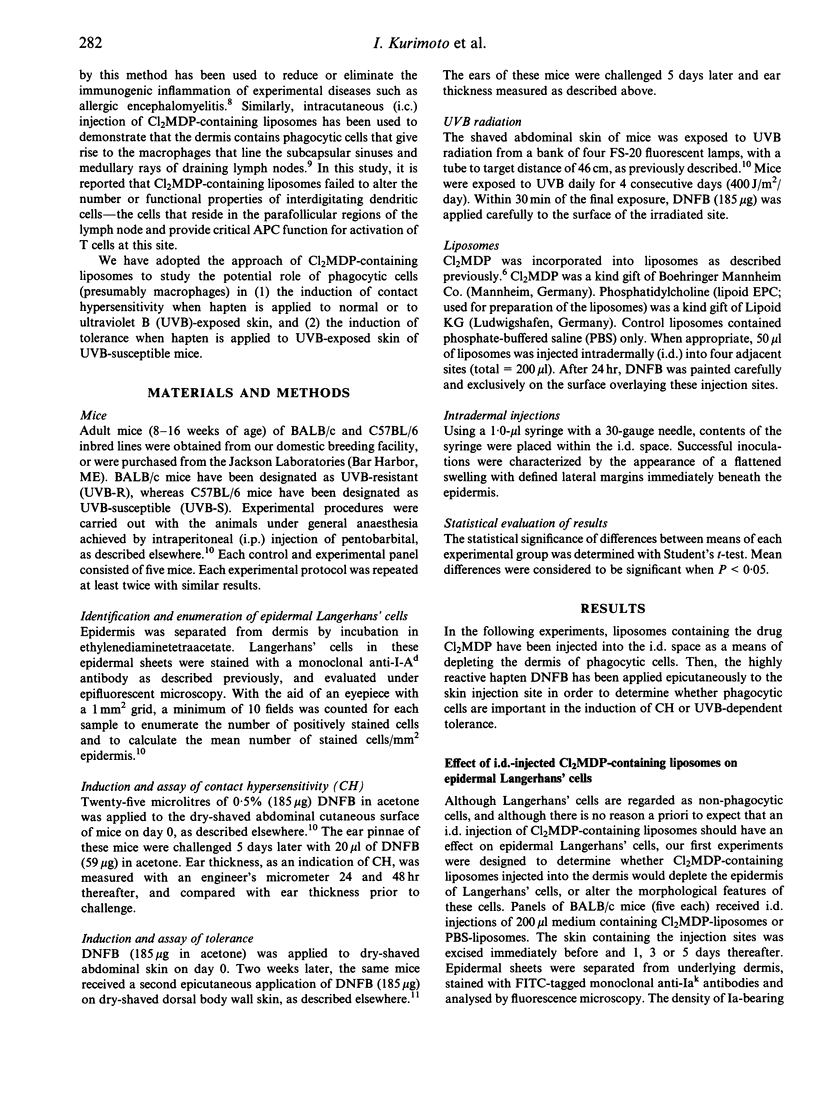
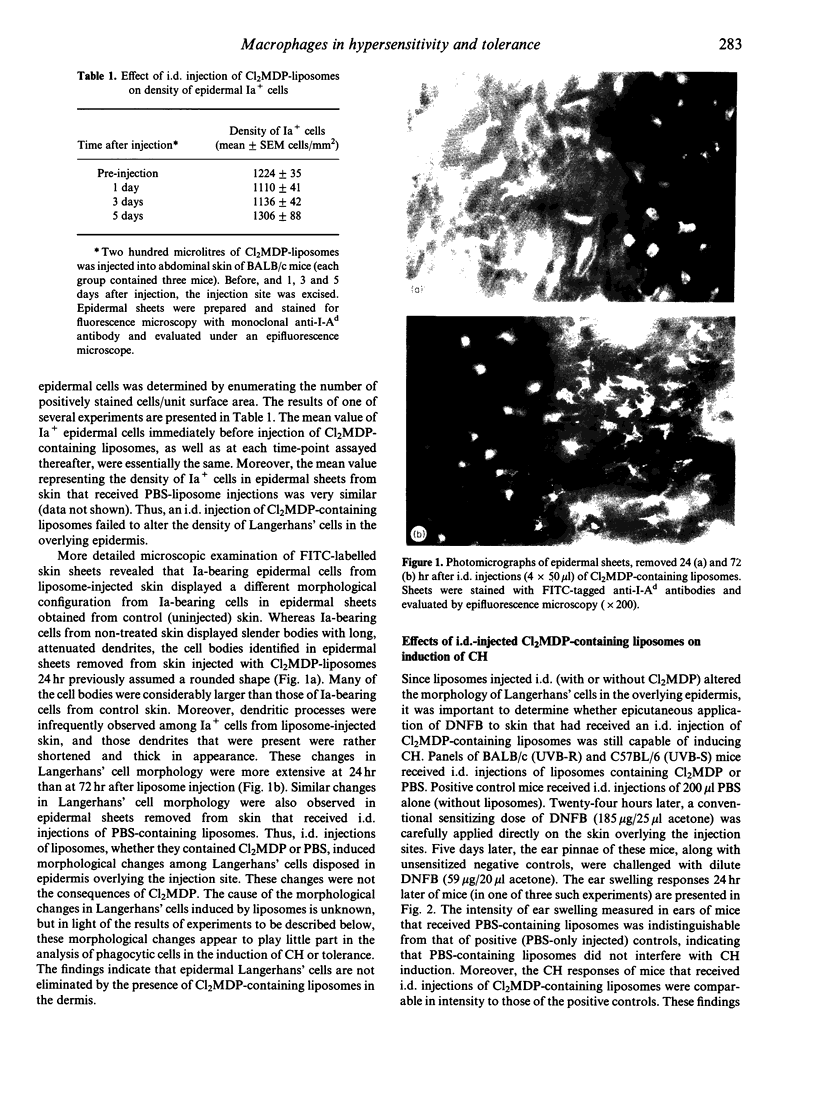
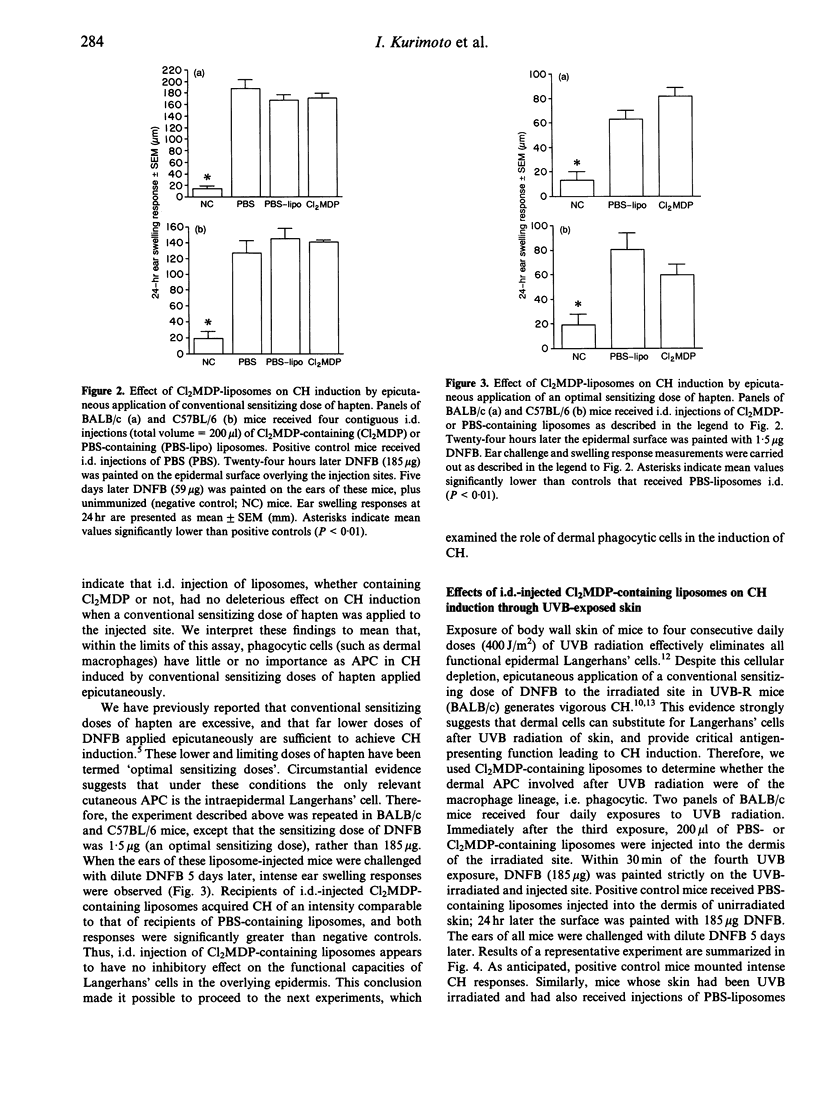
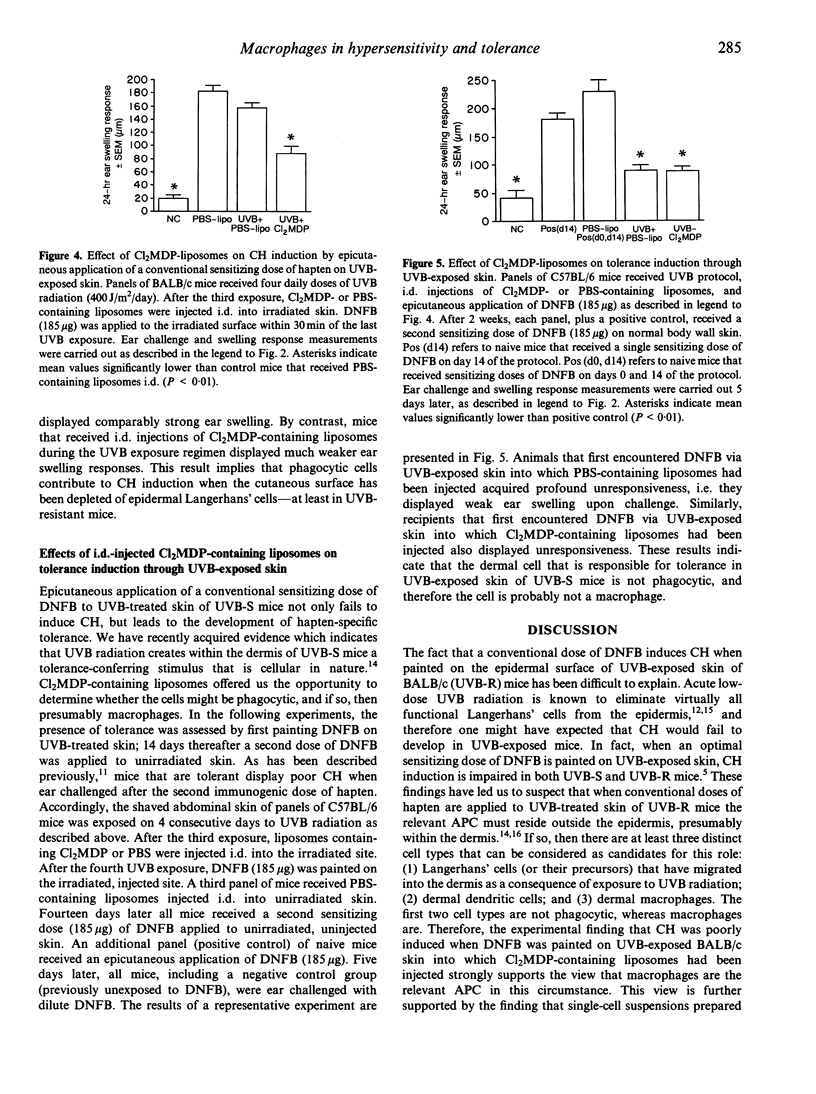
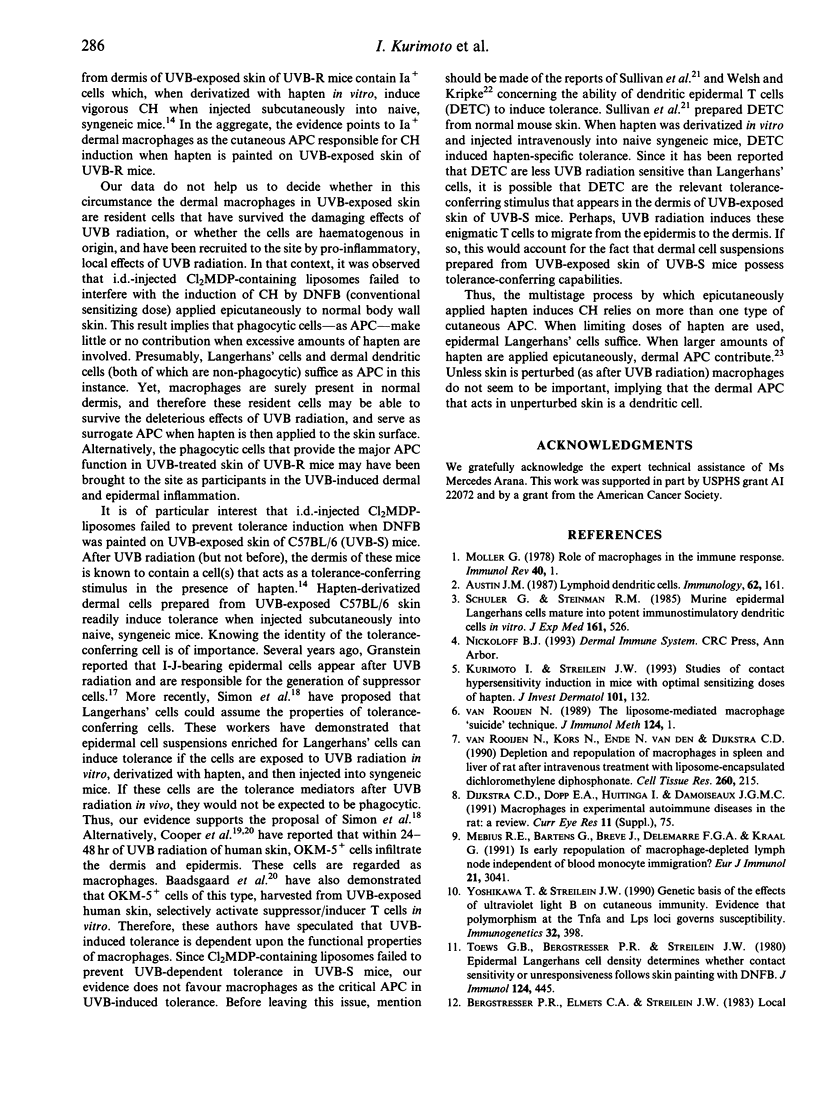
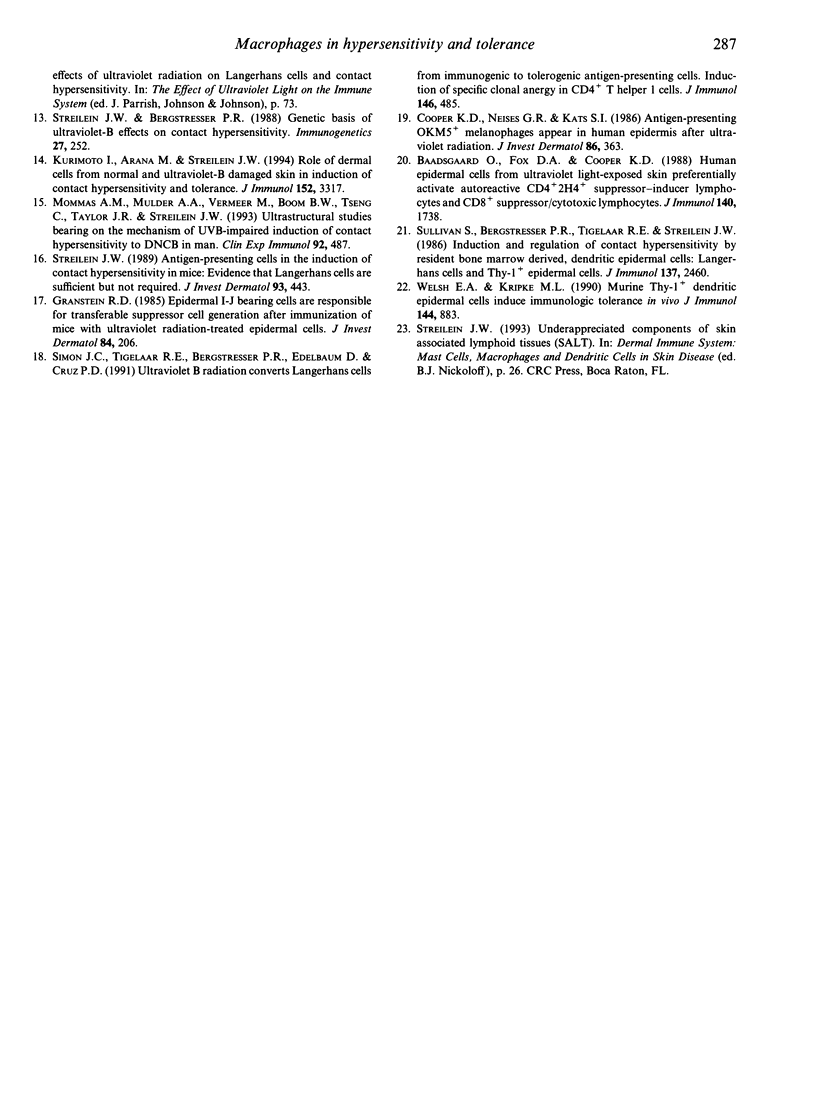
Images in this article
Selected References
These references are in PubMed. This may not be the complete list of references from this article.
- Austyn J. M. Lymphoid dendritic cells. Immunology. 1987 Oct;62(2):161–170. [PMC free article] [PubMed] [Google Scholar]
- Baadsgaard O., Fox D. A., Cooper K. D. Human epidermal cells from ultraviolet light-exposed skin preferentially activate autoreactive CD4+2H4+ suppressor-inducer lymphocytes and CD8+ suppressor/cytotoxic lymphocytes. J Immunol. 1988 Mar 15;140(6):1738–1744. [PubMed] [Google Scholar]
- Cooper K. D., Neises G. R., Katz S. I. Antigen-presenting OKM5+ melanophages appear in human epidermis after ultraviolet radiation. J Invest Dermatol. 1986 Apr;86(4):363–370. doi: 10.1111/1523-1747.ep12285600. [DOI] [PubMed] [Google Scholar]
- Granstein R. D. Epidermal I-J-bearing cells are responsible for transferable suppressor cell generation after immunization of mice with ultraviolet radiation-treated epidermal cells. J Invest Dermatol. 1985 Mar;84(3):206–209. doi: 10.1111/1523-1747.ep12265141. [DOI] [PubMed] [Google Scholar]
- Kurimoto I., Arana M., Streilein J. W. Role of dermal cells from normal and ultraviolet B-damaged skin in induction of contact hypersensitivity and tolerance. J Immunol. 1994 Apr 1;152(7):3317–3323. [PubMed] [Google Scholar]
- Kurimoto I., Streilein J. W. Studies of contact hypersensitivity induction in mice with optimal sensitizing doses of hapten. J Invest Dermatol. 1993 Aug;101(2):132–136. doi: 10.1111/1523-1747.ep12363616. [DOI] [PubMed] [Google Scholar]
- Mebius R. E., Martens G., Brevé J., Delemarre F. G., Kraal G. Is early repopulation of macrophage-depleted lymph node independent of blood monocyte immigration? Eur J Immunol. 1991 Dec;21(12):3041–3044. doi: 10.1002/eji.1830211221. [DOI] [PubMed] [Google Scholar]
- Mommaas A. M., Mulder A. A., Vermeer M., Boom B. W., Tseng C., Taylor J. R., Streilein J. W. Ultrastructural studies bearing on the mechanism of UVB-impaired induction of contact hypersensitivity to DNCB in man. Clin Exp Immunol. 1993 Jun;92(3):487–493. doi: 10.1111/j.1365-2249.1993.tb03426.x. [DOI] [PMC free article] [PubMed] [Google Scholar]
- Role of macrophages in the immune response. Immunol Rev. 1978;40:1–255. [PubMed] [Google Scholar]
- Schuler G., Steinman R. M. Murine epidermal Langerhans cells mature into potent immunostimulatory dendritic cells in vitro. J Exp Med. 1985 Mar 1;161(3):526–546. doi: 10.1084/jem.161.3.526. [DOI] [PMC free article] [PubMed] [Google Scholar]
- Simon J. C., Tigelaar R. E., Bergstresser P. R., Edelbaum D., Cruz P. D., Jr Ultraviolet B radiation converts Langerhans cells from immunogenic to tolerogenic antigen-presenting cells. Induction of specific clonal anergy in CD4+ T helper 1 cells. J Immunol. 1991 Jan 15;146(2):485–491. [PubMed] [Google Scholar]
- Sreilein J. W. Antigen-presenting cells in the induction of contact hypersensitivity in mice: evidence that Langerhans cells are sufficient but not required. J Invest Dermatol. 1989 Oct;93(4):443–448. doi: 10.1111/1523-1747.ep12284018. [DOI] [PubMed] [Google Scholar]
- Streilein J. W., Bergstresser P. R. Genetic basis of ultraviolet-B effects on contact hypersensitivity. Immunogenetics. 1988;27(4):252–258. doi: 10.1007/BF00376119. [DOI] [PubMed] [Google Scholar]
- Sullivan S., Bergstresser P. R., Tigelaar R. E., Streilein J. W. Induction and regulation of contact hypersensitivity by resident, bone marrow-derived, dendritic epidermal cells: Langerhans cells and Thy-1+ epidermal cells. J Immunol. 1986 Oct 15;137(8):2460–2467. [PubMed] [Google Scholar]
- Toews G. B., Bergstresser P. R., Streilein J. W. Epidermal Langerhans cell density determines whether contact hypersensitivity or unresponsiveness follows skin painting with DNFB. J Immunol. 1980 Jan;124(1):445–453. [PubMed] [Google Scholar]
- Van Rooijen N., Kors N., vd Ende M., Dijkstra C. D. Depletion and repopulation of macrophages in spleen and liver of rat after intravenous treatment with liposome-encapsulated dichloromethylene diphosphonate. Cell Tissue Res. 1990 May;260(2):215–222. doi: 10.1007/BF00318625. [DOI] [PubMed] [Google Scholar]
- Van Rooijen N. The liposome-mediated macrophage 'suicide' technique. J Immunol Methods. 1989 Nov 13;124(1):1–6. doi: 10.1016/0022-1759(89)90178-6. [DOI] [PubMed] [Google Scholar]
- Welsh E. A., Kripke M. L. Murine Thy-1+ dendritic epidermal cells induce immunologic tolerance in vivo. J Immunol. 1990 Feb 1;144(3):883–891. [PubMed] [Google Scholar]
- Yoshikawa T., Streilein J. W. Genetic basis of the effects of ultraviolet light B on cutaneous immunity. Evidence that polymorphism at the Tnfa and Lps loci governs susceptibility. Immunogenetics. 1990;32(6):398–405. doi: 10.1007/BF00241633. [DOI] [PubMed] [Google Scholar]



